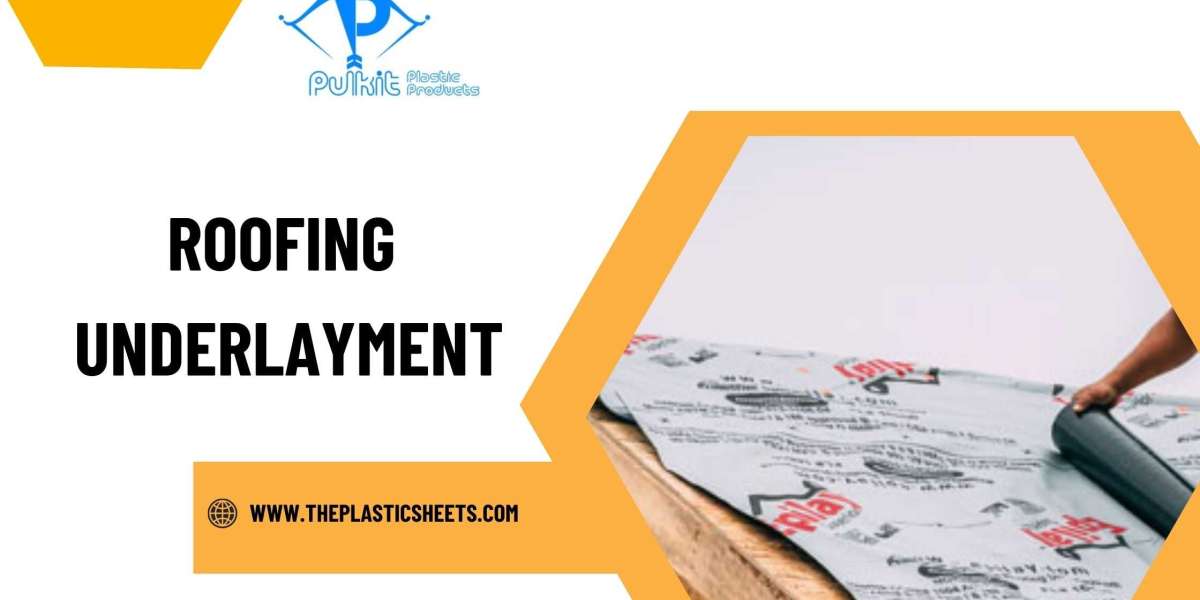When it comes to roofing, many homeowners often focus on the more visible components such as shingles, tiles, or metal panels. However, one of the most important elements of a roof that works behind the scenes to protect your home is the roof underlayment. This often-overlooked material plays a critical role in enhancing the longevity, durability, and performance of your roof. In this article, we’ll explore what roofing underlayment is, why it’s so crucial for your roof, the different types of underlayment available, and how it plays a vital role in various roofing systems, including roof underlayment for metal roofs. Additionally, we will touch upon the Best roofing underlayment options, its availability in India, and mention Pulkit Plastic Products, a company that offers high-quality roofing solutions.
What is Roofing Underlayment?
Roof underlayment is a layer of material that is installed directly onto the roof deck before the roof covering (such as shingles, tiles, or metal panels) is placed. It serves as a protective barrier against water, wind, and other environmental elements that could damage the structure beneath. Underlayment acts as an additional layer of defense, ensuring that moisture does not seep into the roof deck, which could lead to rot, mold growth, and structural damage.
The Importance of Roofing Underlayment
Moisture Protection: One of the primary functions of roofing underlayment is to provide a waterproof barrier. If the roof covering (such as shingles or tiles) becomes damaged due to storms, aging, or other factors, the underlayment prevents water from infiltrating the roof deck. This is particularly important in areas that experience heavy rainfall or snow, as underlayment ensures water doesn't reach the interior of your home.
Wind Resistance: Roofing underlayment helps to secure your roof against strong winds by providing an additional layer of attachment to the deck. Wind can easily lift shingles, tiles, or metal panels, but a quality underlayment ensures the roof covering remains in place, even during extreme weather conditions.
Protection Against Ice Dams: In colder climates, underlayment can be particularly important in preventing ice dams. When snow on the roof melts and refreezes at the eaves, it can cause water to back up under the shingles, leading to leaks. Underlayment prevents such water infiltration by offering a secondary waterproofing layer.
Enhanced Durability: Underlayment can also help prolong the life of your roof by acting as a shield against harsh elements like UV rays, moisture, and extreme temperatures. It protects the roof deck from direct exposure to these factors, reducing the risk of damage to the main roofing material.
Improved Roof Performance: In addition to protecting the roof structure, underlayment contributes to the overall performance of the roof system. It can help in noise reduction (especially with metal roofs) and improve the thermal performance of your roof by providing an extra layer of insulation.
Types of Roofing Underlayment
There are several types of roofing underlayment, each with specific features, pros, and cons. The most common types are:
Asphalt-Saturated Felt Underlayment: This is the traditional roofing underlayment material and is commonly used in shingle roofs. It is made from felt that is saturated with asphalt to provide waterproofing. This type of underlayment is affordable, easy to install, and works well in many climates. However, it may not be as durable as other options, especially in areas with extreme weather conditions.
Synthetic Underlayment: Made from polymer materials, synthetic underlayment is stronger, more durable, and lightweight compared to asphalt-saturated felt. It provides superior protection against water, wind, and UV rays. Synthetic underlayment is ideal for those looking for a long-lasting option with enhanced durability, and it performs well under a wide range of conditions.
Rubberized Asphalt Underlayment: This type of underlayment is typically used in high-performance roofing systems, including metal roofs. It’s a self-adhesive underlayment that provides superior waterproofing properties and resists tearing and puncturing. It’s perfect for climates with heavy snow, rain, and wind.
Peel-and-Stick Underlayment: Often made of rubberized asphalt, this type of underlayment is self-adhesive, which makes installation easier. It’s ideal for use in areas that are particularly prone to water infiltration, such as around valleys, eaves, and chimneys.
Roof Underlayment for Metal Roofs
Metal roofs are growing in popularity due to their durability, longevity, and energy efficiency. However, metal roofs have unique requirements when it comes to underlayment. Roof underlayment for metal roofs needs to be chosen carefully to complement the characteristics of the roofing material.
Metal roofs are more prone to condensation because of the temperature changes that metal experiences. This is why it’s essential to use an underlayment that can prevent moisture buildup between the metal panels and the deck. Additionally, metal roofs tend to be more prone to movement due to expansion and contraction, so a durable underlayment is necessary to ensure the metal panels stay securely in place.
The best underlayment for metal roofs is typically synthetic or rubberized asphalt because of their waterproofing qualities and ability to withstand the expansion and contraction associated with metal roofing. A self-adhesive rubberized asphalt underlayment is often recommended, as it creates a strong bond with the metal surface, preventing any potential issues with water infiltration.
Best Roofing Underlayment
When choosing the best roofing underlayment, it’s important to consider your roof type, local climate, and specific performance needs. For example:
- If you live in an area with extreme weather conditions (heavy rain, snow, or wind), synthetic underlayment is likely your best option for its superior protection.
- If you’re installing a metal roof, rubberized asphalt underlayment or a synthetic underlayment designed for metal roofs will provide the best protection.
- For those on a budget, asphalt-saturated felt underlayment may be sufficient, though it may not offer the same level of durability and performance as synthetic options.
Choosing the right roofing underlayment ensures your roof will last longer and perform better.
Roofing Underlayment in India
In India, roofing underlayment options are expanding as the demand for durable and reliable roofing systems grows. Homeowners and builders in India have a variety of options to choose from, including synthetic and asphalt-saturated felt underlayment. With diverse climates across the country—ranging from hot and dry to humid and monsoon-prone areas—it’s essential to select an underlayment that can handle moisture, temperature variations, and heavy rainfall.
Many Indian manufacturers, such as Pulkit Plastic Products, are providing high-quality roofing underlayments to meet the growing demand for reliable roofing systems. Pulkit Plastic Products offers durable, cost-effective underlayment solutions that cater to various roofing needs, ensuring that roofs remain strong and protected for years to come.
Conclusion
Roofing underlayment is a vital component of any roofing system, providing additional protection against the elements and enhancing the roof’s overall performance. Whether you have asphalt shingles, tile, or metal roofing, choosing the right Roof underlayments in india ensures that your home stays safe, dry, and secure for many years. By understanding the importance of roofing underlayment, selecting the best material for your needs, and working with reliable suppliers like Pulkit Plastic Products, you can make sure your roof is protected against the elements and continues to perform at its best.
FAQs
Q: How long does roofing underlayment last?
A: The lifespan of roofing underlayment depends on the material used. Asphalt-saturated felt can last around 10 to 20 years, while synthetic underlayment can last 30 years or more. Rubberized asphalt underlayment, commonly used in high-performance systems, can also last for several decades.
Q: Can I install underlayment myself?
A: While it is possible to install roofing underlayment as a DIY project, it’s generally recommended to hire a professional to ensure proper installation. Incorrect installation can lead to leaks and other roof issues.








